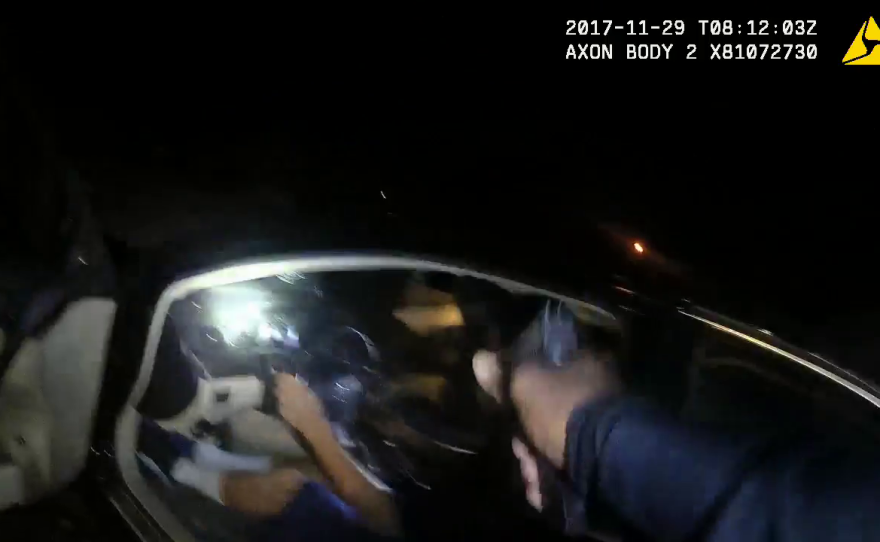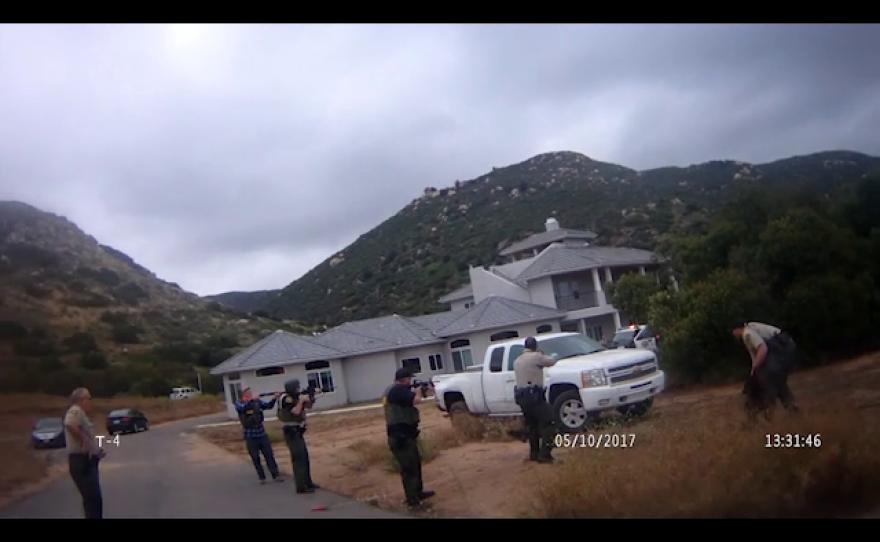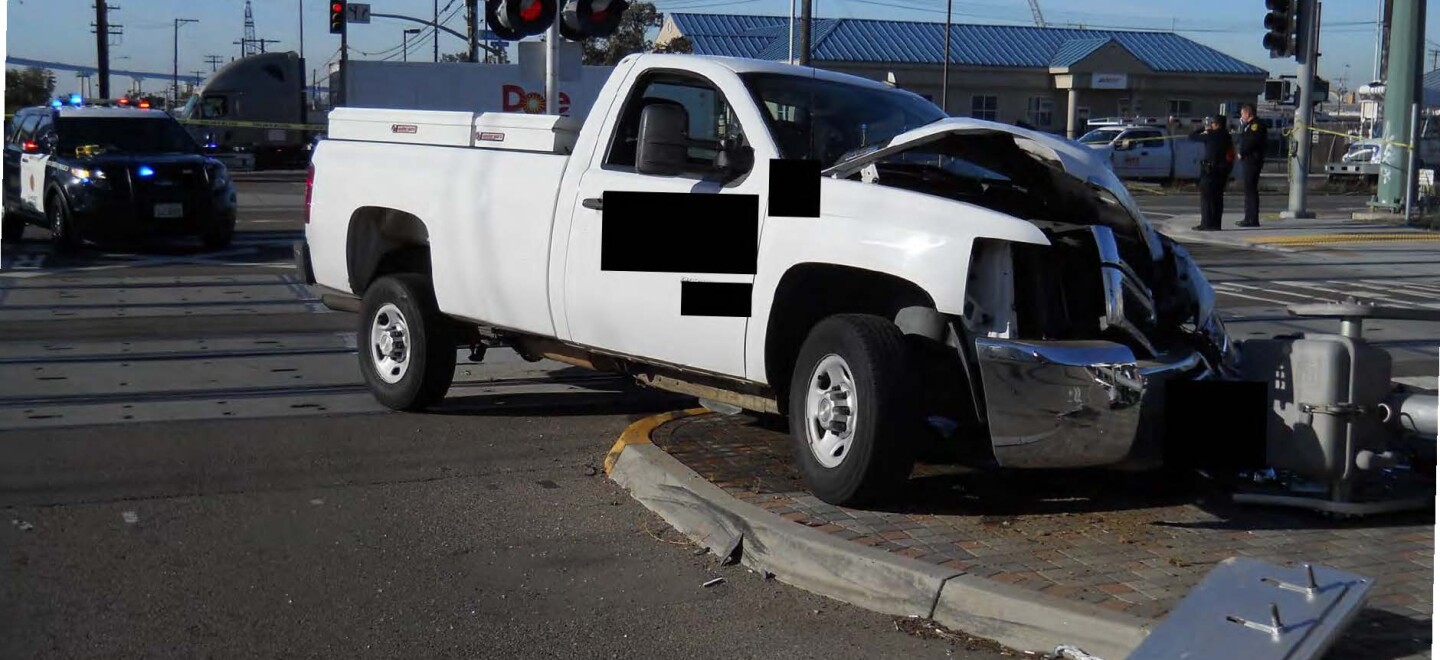Part two in a three-part series. Read part one here.
It was a cool day in January 2018 when 32-year-old Jessica Turner stole a white pickup truck out of the San Diego Convention Center parking garage.
Unfortunately for Turner, two San Diego Police Department officers were in the area and chased after her in separate squad cars.
When Turner made a U-turn, Officer Darrius Jamsetjee jumped out of his car and ran toward her. He later said Turner accelerated the pickup truck toward him, but then drove around him to get away.
Still, Jamsetjee shot at the unarmed Turner as he stood on the street. Meanwhile, Officer Angel Vidrios stayed in his car and fired four rounds at Turner through his windshield. None of the shots hit Turner, but she crashed the truck and was arrested a few minutes later.
This is just one of 20 instances over the past decade when police officers in San Diego County shot at vehicles. Here are some other examples:
- In January 2016, El Cajon police Officer Samson Pak was chasing a man driving a stolen car. Pak got out of his patrol car, and the driver accelerated his car toward and then passed Pak. Pak shot at the car, missing the driver but hitting a woman in the passenger seat. The woman died.
- In November 2017, San Diego police Officer Jarrell Davis walked up to a car in a parking lot in Clairemont and asked the occupants, “What’s up with the meth pipes and s---?” The driver was initially cooperative with Davis, but then threw the car in reverse and attempted to escape. Davis chased the car and shot at it as it drove away, wounding the driver.
- In May 2017, Barona Tribal Security asked for assistance with a man who was allegedly trespassing on the Barona Indian Reservation. Several San Diego County Sheriff’s deputies responded, but the man refused to talk and drove away in his truck. They chased him and when he stopped in a driveway, they got out of their vehicles. When the man backed the truck up toward the deputies, sheriff’s Detective Patrick Farber and Deputy Matthew Addebrooke shot him. He drove his truck off the road and crashed into a tree, dying at the scene.
Shooting at a moving vehicle is one of the most dangerous things a law enforcement officer can do, according to police training experts. If a bullet hits the driver, the car is likely to continue moving and crash. Bullets can also ricochet off the car or truck and put other lives at risk.
“It's not going to stop the vehicle, the vehicle is going to continue to travel and it could strike other people and you could miss and hit somebody else,” said Travis Norton, a police use of force expert and trainer.

This is why police departments generally prohibit such shootings except under the most narrow of circumstances.
Local police officers have not always obeyed that ban.
“It's not going to stop the vehicle, the vehicle is going to continue to travel and it could strike other people and you could miss and hit somebody else.”— Travis Norton, a police use of force expert and trainer
Between 2012 and 2018, officers from San Diego County police agencies shot at people in cars 20 times, according to internal investigation records released under state law SB 1421. Officers missed the driver eight times, and once hit a passenger instead. Four of the drivers who were hit died. In 13 of these cases, the driver crashed the car during or after the shooting.
There are likely more examples as local departments still haven’t released all the records on use-of-force incidents that they are required to under the law.
That there are any such incidents is questionable given that department policies generally prohibit such shootings, experts say. The San Diego Police Department’s policy only justifies these shootings if the vehicle “poses an immediate threat of death or serious physical harm” to the officer or other people and “there is no reasonable alternative for the officer to avoid the harm.”
The policy also warns that: “Firearms are found to be generally ineffective in stopping vehicles;” officers should not shoot at a car “solely in an attempt to disable the vehicle;” and shooting “could create a danger to the public that outweighs the need to use deadly force.”
San Diego Police officials declined to be interviewed for this story.
A new state law enacted in 2020 could further restrict when shooting at cars is allowed. It says officers can shoot only to stop someone getting away “if the officer reasonably believes that the person will cause death or serious bodily injury to another unless immediately apprehended.” The law also requires agencies have policies that outline when officers should fire at moving vehicles.
RELATED: Search the police records database
Though Norton, the use of force expert, is not familiar with the Jessica Turner case, he said the police officers who shot at her could have broken the new law had it been in place at the time. Neither officer was charged or disciplined for the shooting.
Turner escaped the incident without serious injury — none of the eight rounds officers fired hit her. In addition to being charged with stealing the truck, Turner was also charged with assault with a deadly weapon because she drove toward the officers.
Records show that when officers are questioned after these shootings, they almost always tell investigators they fired because they felt threatened by the car.
This should not be their first instinct, Norton said. Proper procedure should be what just about everyone else does when feeling threatened by a car — get out of the way.
“If the officer can get out of the way, they should get out of the way, because that vehicle is going to continue to travel, even though they shoot the driver,” he said.
RELATED: Records Show Racial Disparities When San Diego Law Enforcement Uses Force
All of the shootings examined by KPBS were found justified by the San Diego District Attorney’s Office and no officers were charged. In only one instance was an officer disciplined, and in that case, it was because he accidentally fired his gun while approaching a suspect in a vehicle.
A shooting in 2008 led the La Mesa Police Department to recommend additional training for officers on when to shoot at moving cars.Life should not imitate art
While movies and TV shows make police pursuits look like a regular part of life, Norton said pursuits should also be used sparingly. Even if they don’t end in a shooting, pursuits can cause injury and damage. Most of the time, officers will ultimately apprehend suspects who initially got away.
RELATED: Questions Surround SDPD’s Use Of Force Training
“You have to do a very quick risk versus gain analysis when you decide to pursue or not to pursue,” Norton said. “And officers are getting a lot better at not pursuing for things like stolen vehicles, which is a property crime. We would rather not injure anybody in the public and let that person go.”
A recent investigation by The New York Times found that over the last five years, police nationwide killed more than 400 people in cars who were not wielding a gun or a knife or under pursuit for a violent crime. More than half the time, officers claimed the vehicle was a threat, the investigation revealed. Times reporters also found that officers often put themselves in danger by stepping in front of moving vehicles or reaching inside.

The new state law, AB 392, also makes it easier for district attorneys to charge officers for shootings, though few have taken that step. San Diego District Attorney Summer Stephan was the first in the state to charge a law enforcement officer with murder since the law was put in place. She cited the new law when charging Sheriff’s Deputy Aaron Russell after he shot a mentally ill man who escaped from a police vehicle and was running away.
“Our actions that lead up to that use of deadly force are now subject to review,” Stephan said. “And having listened to some DAs talk about exactly this, they will start considering it when the radio call went out or when they first got on the radio. They're going to start to consider all of those factors in their decision that led up to that (shooting). What was the suspect doing? What did I do? What were my actions prior to my decision to or not to use deadly force?”Clear guidelines
Stephan said the law also clarifies when officers can shoot at vehicles “in a pretty concrete way.”
"The standard is clear, that the person in the vehicle has to have committed a felony that has a potential for serious bodily injury or death, and that if you let them flee, they could harm somebody in a way that would result in serious bodily injury or death.”— Summer Stephan, San Diego County district attorney
“So this wasn't spelled out before, and what it says now is the standard is clear, that the person in the vehicle has to have committed a felony that has a potential for serious bodily injury or death, and that if you let them flee, they could harm somebody in a way that would result in serious bodily injury or death,” she said.
But the law has not been applied, at least locally, to cases where a suspect was using a vehicle to flee and an officer shot. In those cases, officers could say they shot because they were afraid they would be hit by the suspect’s vehicle.
In interviews with San Diego Police Department homicide detectives, the officers who shot at Turner were asked to justify their decision.
“If she was going to be going straight into traffic without looking, which could possibly cause a collision,” Jamsetjee said. “We have a lot of motorcycles that go down Harbor as well. So that could have been deadly.”
With that answer, Jamsetjee did not clearly state that he felt the unarmed Turner posed an immediate threat of death, as the department policy requires. But then his attorney from the police union cut in and elicited a more specific answer from him.
“If I may?” she asked.
“Yes,” the sergeant told her.
“What did you think would happen if that suspect vehicle got away?” the lawyer asked.
“She was gonna kill somebody,” Jamsetjee said.
The California Reporting Project contributed to this story.








